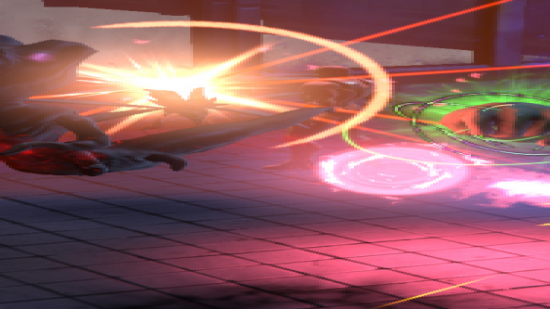What developer Gazillion Entertainment are aiming for with Marvel Heroes is a realisation of last year’s Avengers film, but in action RPG form. But doubled. No, quadrupled. Actually, let me just do some sums…
Joss Whedon’s film had six superheroes chomping around New York. Gazillion want to put together groups of superheroes that are more than eight times as big, sending them out into the city to fight crime, battle aliens and beat up the deadliest supervillains. Their vision is of an action RPG where up to fifty heroes band together in one instance to wrestle hordes of foes that have been carefully scaled to match their ability, in street fights of incredible size and intensity across levels that endlessly reinvent themselves.
And it’s all free.
That vision in more detail: Marvel Heroes is an ARPG on a scale previously unseen, an upscaled version of something like Diablo, but allowing for far greater numbers of players to band together and bring the pugilistic pain that is true justice to a world of crime. It has a story penned by multi-award winning comics writer Brian Michael Bendis and it intercuts its action with more than an hour’s worth of sharp, stylish comic book vignettes drawn by Marvel artists and voiced by Marvel character actors.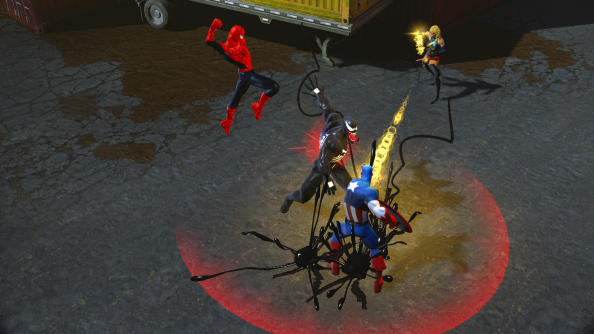
It also features an awful lot of superheroes. It’s swimming in Marvel lore, starring everyone from the Hulk to Thor, Thing and Black Widow, arraying them against bad guys from The Green Goblin to Dr. Doom. Nick Fury comes through on the intercom and Agent Coulson takes charge in the field.
Working the machinery is David Brevik, Gazillion’s chief operating officer and the former co-founder of Blizzard North. Brevik was a lead designer on the first two Diablo games and the influence he’s brought to Marvel Heroes is immediately obvious. This is an isometric ARPG that in so many ways looks and feels like Diablo 2, from the often frantic pace of the combat to the nuances of the character skill tree. But this time everything is bigger. “We’re taking Diablo 2 to the next level. We’re taking an action RPG and we’re turning it into an MMO,” says Brevik, before adding one of his most important points: “And the entire thing is free.”
Marvel Heroes is anything but a pushover. Enemies numbers and abilities increase in proportion to the heroes that face them. Even a modestly-sized level with just four supercharged superheroes racing through it presents a throng of opponents to fight. What’s more, they gradually respawn, keeping the levels alive with action and the players on their toes.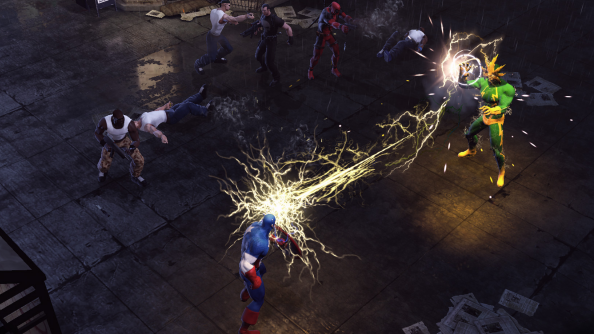
Of the 22 superheroes available, each has their own skill tree, which you can gradually grow to suit your tastes. There’s a mix of active and passive skills: your choices mean that, should you find you’re working together with someone else who also happens to play, say, Spiderman, you can still have quite different abilities at your sticky fingertips.
Many of these abilities are designed for co-op play. While some heroes might get by on their own, it makes things a hell of a lot easier when you have one buddy who has stun abilities, another who has a team buff. Marvel Heroes has been built from the ground up for large teams of superheroes to get together and bring their personalities to the fight, stepping into all the traditional MMO roles and everything in between. You’ll need them all, too, because fights are fast-moving and constantly task your team to maneuver and to make use of all their abilities, offensive and defensive.
Take the first boss fight I found myself in against a supercharged Green Goblin. Riding on his goblin glider, he’s continually on the move and constantly hurling bombs that create great green clouds of poison gas around him, all of which makes him very difficult to handle in melee. He’s fast, too, and when he closes in to strike he can do incredible damage, so our cabal of heroes had to duck and dive their way through the combat.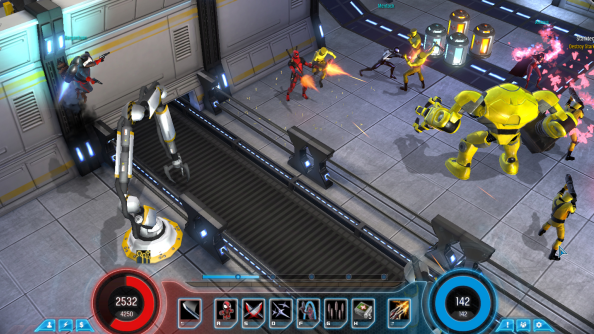
Controlling Deadpool, who has ranged attacks in the form of pistols and grenades, I could stand back and inflict as much damage as possible, as well as try and lure the Goblin toward me and out of whatever gas of poison he had formed around him. I couldn’t handle the melee, though, and at this point it was Thor’s job to step in and stun him so that the rest of us had the chance to land some easier hits. Should any of us fall, a comrade could take a few seconds to revive us, but in a fight as fast as this that can feel like forever, especially when you’re so pressed to keep moving. The result was a fight that felt fast, dynamic and often very intense.
Gazillion’s emphasis is on variety. Regardless of who you begin playing as, you can still unlock all the other heroes in the game. Once a hero’s added to your roster you can quickly switch control to them, summoning them into the battle, albeit with a short delay that makes this unwise if you’re in a fight. The game’s levels are procedurally generated. Brevik very much enjoys the surprise and the possibility that this brings and it was a major part of the first two Diablo games, though he adds that it’s much less common for games to feature it nowadays, making it something of a design challenge.
“I love it,” he says. “I grew up playing all these randomly-generated games. Some of the best board games I’ve been playing recently have had a lot of randomisation in them. That was one of the harder things that we’ve done, because a lot of the expertise we had there [in Diablo 1 and 2], the people who had done this sort of thing in the past, didn’t do it this time. I had to train a lot of people on how to do random content. We had to educate all our people on and from an artist’s standpoint, it’s very strange. It’s very foreign to them, it’s very different than the way that they normally make levels: all the little pieces, all the random elements.”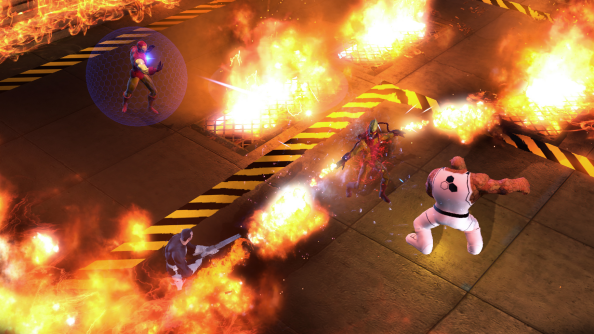
With time and with a lot of testing and balancing of the procedural generation routines, Brevik believes his team can create levels that are as varied and exciting as anything that’s pre-constructed or, God forbid, scripted. “I find scripted encounters too repetitive,” he says. “I like the variance, it changes my tactics, it changes the dynamics of the situation and it makes the entire experience more replayable, which is something that’s a goal of ours.”
The ever-spawning bad guys should also bring more variety and intensity to the game, he hopes, as well as something quite different to the clean out, move on play of other games: “We keep track of where everybody is and then determine where they’re going and where to spawn guys to keep the action flowing instead of, like in a traditional MMO, a respawn [which] is a group of monsters where you kill one and another one respawns in three minutes. You definitely feel like there’s plenty of things to do and plenty of mobs to kill as you’re going, which gives you that core action roleplaying feel.”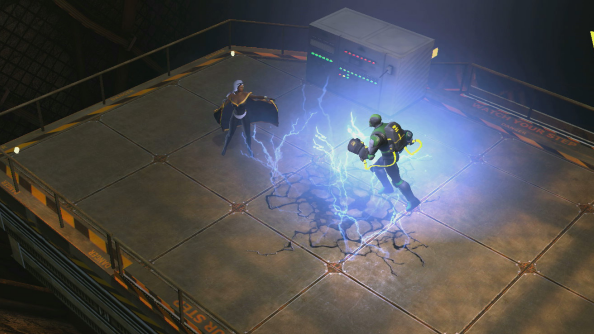
So how do Gazillion get paid?
They’ve decided to follow the example set by Riot Games and League of Legends, giving players the chance to pay to unlock heroes that they’d otherwise have to earn through the course of play. There will also be a wardrobe’s worth of different costumes that can be bought and used to customise the look of you hero. As with League of Legends, these new outfits are only cosmetic and won’t make you any more powerful, but the idea is you will look much, much cooler. Brevik believes this business model can work perfectly well for Marvel Heroes and that, when players know what’s waiting for them in the game, they won’t mind handing over a little change if it helps them to get the things they want most.
“The idea is to be generous with what we’re giving and I feel that if we are that way, then people will respect that,” he says. “I think that League of Legends is a good example of this. It’s a game that you can play completely for free, unlocking all the heroes and doing all the things you want to do. I want to take the same approach.” That same approach also involves following what has become the golden rule of free-to-play gaming, ensuring that nothing that players buy gives them any advantage over those who are playing for free. Brevik adds that the team are considering also offering small increases in magic item find or experience boosts as part of microtransaction packages, but emphasises that “we’re not going to sell power.”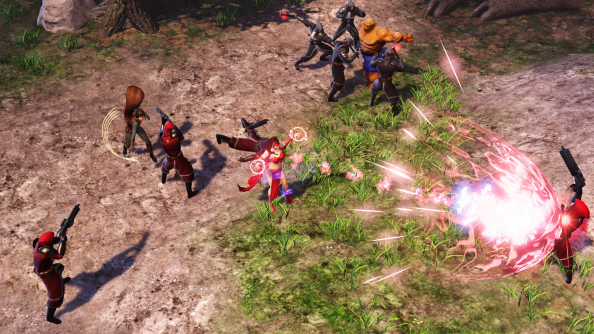
Brevik also hopes to encourage a vibrant economy of player trading, though strictly with in-game currency. While all item drops are individually instanced, meaning players only see and collect their own loot and experience, you may occasionally pick up items that aren’t relevant to your character, items that you may want to pass on. “We’d like to have an auction house,” says Brevik. “Not a real money auction house, but an auction house like you’d have in World of Warcraft where you can pick up an item for in-game credits.”
Naturally, because the comic book giant are protective of their intellectual property, the game has been developed in very close partnership with Marvel. This hasn’t simply been the publisher leaning over Gazillion’s shoulder to tut at their character designs, says Brevik, though he does say that sometimes character designs “will come back with a note on like ’Wolverine’s claws are too long’ or ‘Iron Man’s eyes are not quite right.’” But this partnership has also enabled the developer to enjoy certain special benefits.
“We worked really closely with them on things like new costumes that are just on the edge of what they’re doing. We have a bunch of Marvel Now costumes that are in there and we started working on those right when Marvel Now was announced, even before they were in the comics,” Brevik continues. “For the Iron Man 3 movie, we actually got the physical model they used for the computer animation. They sent it to us and then we could take that model and put it in the game.”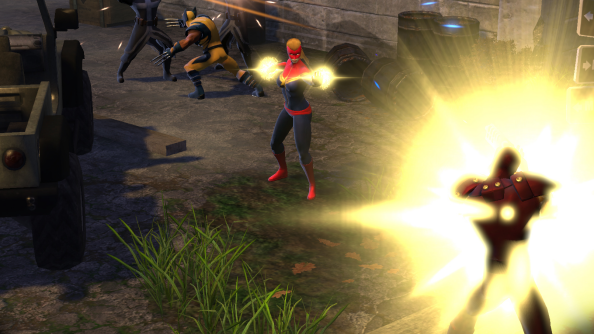
Brevik’s also excited for the chance to work on something that will continue to grow and it’s no surprise to learn that he plans to add more heroes, more costumes and more goons as the game expands. He explains that it’s quite different to working on the first two Diablo games, which were primarily designed for a single player to fight their way through, explaining that the first Diablo’s multiplayer was added almost as an afterthought towards the close of development.
It comes down to balance. Gazillion is still precisely tweaking and expects to continue to balance even once the game is live. The opportunity to shape and perfect the game based on player feedback is something Brevik sees as a boon. “One of the things that’s attractive to me about this project is the ability to add on to a fantastic base and that’s something I’ve never really been able to do before, to continually upgrade a particular game and make it kind of a long-term vision,” he says. ”I have lots of ideas of where I’d like to take this and reacting to the community and guiding this thing over the course of several years is something that’s really exciting.”
Marvel Heroes has been in closed beta for six months now, occasionally allowing small groups of new players step into its world. It doesn’t yet have a release date. While most of us may not be able to play it for some time, it’s already a polished, exciting and often frantic game. Diablo III, beware.
